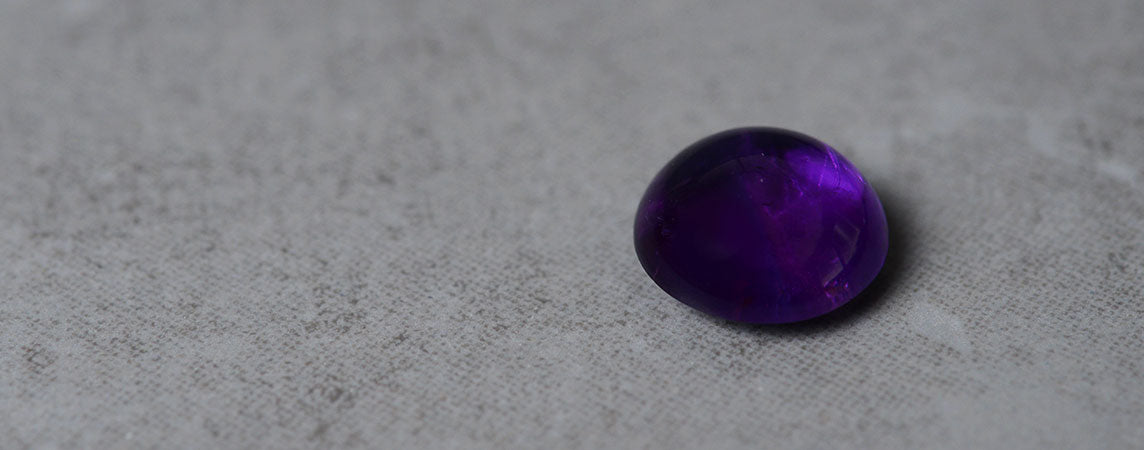THE AMETHYST
Since the dawn of time, amethyst has been noticed by people the world over, and is one of the world's most widespread gems. Present everywhere, it is no less unique for its history and its color, which oscillates between purple, violet and violet-red.
Numerous legends and powers are attributed to it, reinforcing the magical aspect of its color, so distinctive from other gems. Both popular and exceptional, it is one of the essential stones whose "sparkle", as Philippe Tournaire puts it, inspires her to sublimate some of her jewels.
Characteristics of a remarkable gem
From the quartz group of minerals, which includes varieties such as citrine and rock crystal, amethyst is the most highly prized of them all. It is a silicon dioxide and owes its color to the presence of iron in its chemical composition. Like all quartz, it has a hardness of 7, just behind topaz. Most amethysts on the market have no visible inclusions. If they do, they are usually cut as cabochons. In general, amethyst is cut in large, often twinned crystals, with the concentration of color usually at the end of the crystal.
Shades of amethyst color
Although nature has created other violet-dominated wonders such as sapphire and tanzanite, amethyst remains the violet stone par excellence . By acting on the chemical elements that make up its crystalline structure, natural irradiation causes areas of concentrated color, giving amethyst the more or less pronounced lavender hue that defines it. By placing the table of a faceted amethyst on white paper, or immersing it under water in a small container, we can better assess the distribution of its intense color, and its sometimes colorless zones, and thus better judge its quality. The less visible the zones of concentration, the more likely the amethyst is to be considered pretty because uniform. It all depends on the depth of its violet: if it's too dark or too light, it's a disadvantage. If amethyst is to dazzle us with its beauty, we need to find the right balance. "For a stone to be beautiful, it must sparkle, it must have life in it", as theartisan jeweller Philippe Tournaire would say. Like him, those who appreciate this gem are looking for an intense violet, sometimes slightly tinged with red, and above all without any visible areas of color concentration likely to detract from the overall harmony that reveals its brilliance.
Treatment and imitation of an essential stone
In order to improve its color and therefore its luster, amethyst is often heated: either to make it lighter, or to make it darker....Tout depends on its nature. In addition to heating treatments, amethyst enjoys undisputed success with all types of cultures, and was first synthesized in the 1950s. With perfect purple amethyst becoming rarer than ever before, manufacturers took inspiration from its natural beauty to create an increasingly convincing fake. It was easier to distinguish the fake from the real until the 1990s, because the stem crystals used to copy it were not large twin crystals as is the case with the natural state in general. From that time onwards, numerous laboratory tests became necessary to make the dissociation.
Amethyst, the universal stone
This jewel of nature may be commonplace due to its abundance throughout the world, but it's no less extraordinary when you consider its cradle, its history and what it is today. Until the 19th century, one of its main sources was Russia. The discovery of large deposits in Brazil made it more accessible. The two most important sources are Paré and Rio Grande Do Sul. Today, amethyst is one of the most popular colored gemstones, and one of the most widely sold in jewelry. Africa - and Zambia in particular - is considered the continent that supplies the finest amethysts. They are also found in Uruguay, Argentina, Arizona, India, Canada, Myanmar, Mexico...in hundreds of countries, on every continent...That's how universal amethyst is! But you don't have to go far to find beautiful amethysts: France is also a source! Clearly, beauty is everywhere...
Amethyst, the legendary stone
Amethyst, attributed to the month of February, is one of the few beautiful stones to be at the origin of the most noticed and recognized stones. Having always adorned the finery of the world's great and good, many mystical stories are associated with it... First of all, its name: derived from the ancient Greek "amethystos", the verb "methyo" meaning "to be drunk", and its color similar to wine cut with water, which would grant it the power to preserve against drunkenness and homesickness.
Not to mention that violet symbolizes religion, royalty, seriousness and piety. In Tibet, it is considered the sacred gem of Buddha. Deeply rooted in the Christian religion, the purple of amethyst symbolizes the heavens and the blood of Christ, being a mixture of red and blue. Many representatives of the Church still wear amethysts on their fingers today. Legend has it that the god of wine, Bacchus, swore revenge for a poor mortal's inappropriate words to him. Then Amethyst appeared, a beautiful young girl eager to do good, who was transformed into a quartz statue by the goddess Diana, to protect her from the ill feelings of the angry Bacchus. Bacchus, realizing his poor judgment, shed tears of wine in remorse for the beautiful statue.
These tears tinted the quartz violet, giving rise to the beautiful gem we know today as amethyst... So ordinary in its abundance, yet so rare in its beauty... This gem knows how to be coveted! Come and discover its brilliance through the original creations of Philippe Tournaire ... Thanks to him, amethyst is sublimated in a fortified village, on an Ionic solitaire or in a tower, and in many other jewels! Amethyst may not be a diamond, sapphire or ruby, but it has earned its place among the greats.
The guarantee of uncompromising craftsmanship
OUR TITLES AND LABELS








